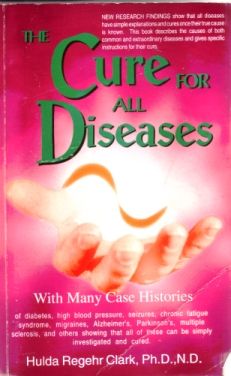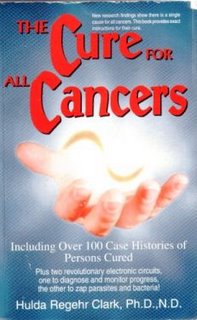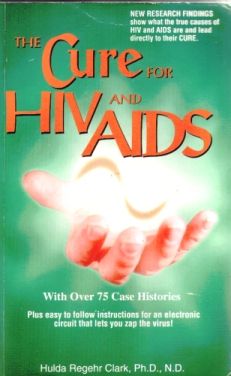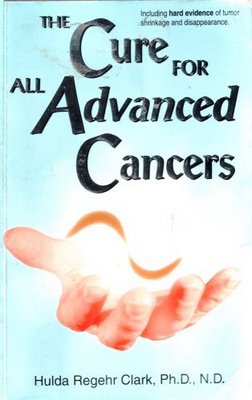Friday, January 20, 2006
Immunity to antibiotics
Antibiotic Resistance Widespread in Nature
THURSDAY, Jan. 19 (HealthDay News) --
Pluck a microbe out of the ground, and it's likely to be resistant to most antibiotics, a new Canadian study finds. Researchers at McMaster University screened 480 strains of bacteria they took from soil and tested them against 21 different antibiotics. Every bacterium was resistant to a number of antibiotics, an average of seven or more, according to the report in the Jan. 20 issue of Science.
"The density of resistance is surprising," said Gerard D. Wright, chairman of biochemistry and biomedical sciences at the university's Michael G. DeGroote School of Medicine. "Old compounds, new compounds, it doesn't seem to matter. They have all sorts of ways to get around these things."
That resistance doesn't come from exposure to antibiotics used in medical treatment, Wright noted. It's just the bacteria's way of surviving in a world full of perils, he explained, since they are surrounded by competing organisms that produce their own natural antibiotics. "This is giving us a glimpse into very complex organisms that have been living for millions of years," Wright said. "They have evolved a really complicated set of strategies that allow them to deal with all sorts of threats, old threats and new threats."
While overuse or just plain use of medical antibiotics is known to increase the incidence of resistance, this study suggests that natural resistance happens without exposure to those drugs, he said. "We got bacteria from a number of sources -- urban environments, agricultural environments, the woods in northern Ontario that has not seen any use of human antibiotics -- and the level of resistance was the same," Wright said.
Most of the genetic mechanisms of resistance seen in the study were already known, but a few new ones showed up, he said. The researchers now are doing more detailed research into the mechanisms by which bacterial alter their genetic function to fight antibiotics. The study has two practical applications, Wright said. "One is to alert clinicians and medical biologists to new methods of resistance than can emerge in the clinic," he said. "And for people who make antibiotics, this should give them a heads-up about methods of resistance they may not see in the clinic today, but may see tomorrow. Clever chemistry might delay resistance being a problem,"
But there is no way to prevent antibiotic resistance occurring, because the strategies built up over millennia can't be dodged completely, Wright said. He noted the researchers found bacteria resistant to telithromycin, one of the newest antibiotics on the market.
"This will just help delay and inform about resistance," Wright said. "It gives people more ammunition to fight it."
The finding could also help refine strategies for finding new antibiotics, said Dr. Stuart B. Levy, a professor of medicine at Tufts University Medical School, and president of the Alliance for the Prudent Use of Antibiotics.
A close look at the study shows that many microbes defend themselves by producing enzymes that break down antibiotics, said Levy, who is also the author of The Antibiotic Paradox. "We may not be finding new antibiotics when we go to the soil to look for them because we don't take into account that they are being destroyed," he said. "We may need new techniques to isolate new antibiotics. Maybe we can do a better job finding them by knowing this."
More information Antibiotic resistance is explained by the Alliance for the Prudent Use of Antibiotics.
Carol Ann
http://www.harmonikireland.com/




Special Report by Grahame Whitehead of The Living Water Workshop
updated 21 September 2002
Inside information on Innovations in Healing with Living Water, Implosion Research, BioScience and Technology
(Editors Note: The discovery of antibiotics and their introduction into medical practice was hailed as one of the most important events in the struggle against human and animal infectious diseases. The Pharmaceutical company driven antibiotic era began in earnest in the early 1940s, penicillin being the first antibiotic introduced into clinical practice. Discovery after discovery by the competing pill pushers then followed and optimism ran high as a vast new worldwide market was suddenly created.
Since that premature, overconfident assertion there has been a powerful resurgence of infectious diseases, beginning in the late 1970s; the single most threatening component of which has been the appearance of disease causing bacteria which have become resistant to Pharmaceutical Antibiotics.
These bacteria have now clearly demonstrated their capacity to develop sophisticated mechanisms of resistance against every type of synthetic antibiotic produced thus far. What’s more, according to Dr Alexander Tomasz, “these resistance mechanisms can find their way from one bacterium (fluke, worm or parasite) to another through a variety of efficient microbial gene transfer mechanisms. Bacteria, flukes, worms and parasites resistant to most pharmaceutical drugs can also travel inside people and animals over large geographic distances or worldwide in water supplies such as the increased incidences of infected domestic drinking water to hit the headlines in both the United Kingdom and Ireland within the previous twelve months. Bacterial pathogens, flukes and worms resistant to all “chemotheraputic agents” are no longer seen as science fiction, thus rendering all such equipments and treatments totally invalid.
The whole subject of parasitic infection within the human body is not covered in any great detail within the western medical educational curriculum and remains the most undiagnosed condition together with current and long term bodily dehydration or chronic water shortage leading to acidic bodily terrain. When the bodily terrain becomes more acidic the various types of bacterium, flukes etc change their morphology (Pleomorphasise) into differing mutations dependant upon the Acidity / Alkalinity of the ambient Bodily terrain. More information on this topic is available from Christine Thorne. P.O. BOX 33, Carmarthen. SA33 6YE Wales. Tel/Fax 01994 484682. Christine Produces a magazine (Finding the Way)
According to Tomasz “the danger of acquiring hospital-borne bacterial disease, often by antibiotic resistant strains, is not by any means restricted to the terminally ill, although patients with serious underlying diseases ( Chronic dehydration ) are at increased risk for all infections. (See our Cancer Living Water and Bio-energy article.) Infection by air borne or water borne antibiotic resistant bacteria is a clear hazard for hospital patients having any surgical operations or minor procedures. Similarly, premature babies in incubation are also at high risk”.
Through the medium of a very small drop for “live blood analysis” under high magnification it is now possible to see the various bacterial toxic clusters, parasites, flukes, worms and various other organisms, toxins and chemical traces such as mercury poisoning from amalgam fillings etc etc etc. The bodily Alkalinity is a vital factor in maintaining optimum health, and as the famous American Master Herbalist Dr Richard Schultz always repeats everywhere he preaches, “You are what you eat” This is especially relevant in the light of the flood of antibiotics, which have entered the food chain in the last several decades. Cows and other farm animals receive more than thirty times the quantities humans are force fed. These antibiotics together with many other chemicals and fertiliser residues remain in the animals flesh, which people then rush to the supermarket to purchase. The western cancer and heart wards are stuffed full of big meat eaters with toxic overload, again a symptom of chronic dehydration, They are paying the price for their own dietary choices, or was it the advertising industry or your Doctor who told everybody what was good for them to eat. People remain unaware that the milk they are buying from down at the supermarket has over 100 different types and brands of antibiotics already added free by the farmers who blames the system, “and shaken not stirred” down at the dairy, he can only do as they tell him, otherwise they will not buy the milk from him. The Food and Drugs administration within the United States has responded accordingly to this situation over the previous decades by constantly ever increasing what they consider are quantities of antibiotics currently safe for human consumption. For further information upon this truth, which is, key to your healing and recovery, see You are what you eat.
According to the claims of the western medical profession, some of the more threatening multi-drug resistant ( MDR ) “BUGS” which have begun to gain a foothold are MDR Pneuniococcus, MDR Staphylococcus auraus, MDR Enterococcusfaecium and MDR Tuberculosis.
The First Penicillin-resistant pneumococcus was supposedly discovered two years before the U.S. Surgeon General acknowledged its existence. It was reportedly found in Papua, New Guinea. By 1977, an epidemic disease caused by pneumoeoccus was being reported by South African hospitals. The bug had not only become resistant to penicillin but all other antibiotics as well, and an increase in its level of resistance by more than several thousand fold was reported. Since the early 1990s MDR Pneumococcus has demonstrated its ability to spread from one country to another, reaching extremely high levels in locations. The highest incidences are currently in third world countries especially Africa where water borne contamination is also a very high added risk factor. See The Great HIV Hoax
Pneumococcus is the culprit behind outbreaks of pneumonia in various communities worldwide. This bacterium is a major threat to public safety because it can be life threatening to certain ill or elderly patients ( accurate figures are unavailable but it is estimated that well in excess of fifty thousand people in the United States die from exposure to pneumococcus each year), we can see currently what is happening when MDR pneumococcus is implanted into and allowed to spread within targeted vaccinated groups worldwide. It also causes life-threatening infections of the bloodstream and meningitis. See The Pharmaceutical Racket.
Pneumococcus is also the culprit behind nearly half of the visits to paediatricians each year, It is the major “causative agent” of very common middle ear infections ( Otitis Media is a major water borne infection ) in young children worldwide. According to Tomasz, young children under the age of two stand a higher risk of acquiring various diseases, which are originally caused by pneumococcus. He says, “Several day-care centres within the United States were shown to have a particularly high frequency of carriage of multi-drug resistant pneumococcal strains. “The bugs have spread through the day care centres “like a chain letter,” says one reporter. Staphylococcus aureus is the most common cause of skin, wound and bloodstream infections found within hospital ward patients. Bio Science Researchers claim one bacterium can leave 16,777,220 offspring within 24 hours. The more a antibiotic is used, the greater the chances that it will kill off the weaker microbes but leave these mutated germs to reproduce. Eventually, these genetically new versions entirely replace the original strains, and the original antibiotic is still consumed but remains totally ineffective.
As antibiotics cause major damage to intestinal flora and our bodies ability to extract nutrition from our daily food intake, I personally recommend home brewing of Kombucha Tea with Living Water. For people currently suffering from antibiotic damage the usual problems with detoxification and repopulation of healthy intestinal flora are best with very easily and economically by taking the responsibility into your own hands and making your own healing beverages. See Kombucha Tea
A increasing number of strains of this pathogen have now become resistant to all commercially available pharmaceutical antibiotics, Vancomycin being the last hope of the pill pushers wonder drugs. However, Enterococcus faecium has already acquired resistance to Vancomycin. In 1992 it had become the third most frequent “causative agent” in relation to hospital-acquired wound and urinary tract infections, septicemia, and endocarditis. So the simple truth is that commercial antibiotics have no power over many types of bacterium, virus, parasite fluke or worm. God help them if they don’t acknowledge this fact now, and start telling the truth for a change.
Many Holistic therapists now point to Doctors and the Pharmaceutical / Banking network for creating the original problem by promoting worldwide indiscriminate and excessive use of pharmaceutical antibiotics without fully investigating or bothering to explain the many contraindications and unacknowledged side effects which these products cause. Antibiotics are specific to bacteria and some types of fungal infections; not viruses, parasites flukes or worms. Doctors should know this and they therefore act irresponsibly when they prescribe pharmaceutical antibiotics for many types of incorrectly diagnosed infestations. For further information covering this whole topic readers are referred to the works of Dr Hulda Clarke.
Books and the latest Zapping technology can be purchased from Health Leads UK. Visit them at http://www.healthleadsuk.com
As A ALTERNATIVE TO commercial Antibiotics I recommend Harmonik Colloidal silver which is made with living water and love.
For full information on how to make your own colloidal silver I first recommend reading both Dr Keith Courtney's Colloidal Silver and My own Living water article for the Bigger Picture. 
THURSDAY, Jan. 19 (HealthDay News) --
Pluck a microbe out of the ground, and it's likely to be resistant to most antibiotics, a new Canadian study finds. Researchers at McMaster University screened 480 strains of bacteria they took from soil and tested them against 21 different antibiotics. Every bacterium was resistant to a number of antibiotics, an average of seven or more, according to the report in the Jan. 20 issue of Science.
"The density of resistance is surprising," said Gerard D. Wright, chairman of biochemistry and biomedical sciences at the university's Michael G. DeGroote School of Medicine. "Old compounds, new compounds, it doesn't seem to matter. They have all sorts of ways to get around these things."
That resistance doesn't come from exposure to antibiotics used in medical treatment, Wright noted. It's just the bacteria's way of surviving in a world full of perils, he explained, since they are surrounded by competing organisms that produce their own natural antibiotics. "This is giving us a glimpse into very complex organisms that have been living for millions of years," Wright said. "They have evolved a really complicated set of strategies that allow them to deal with all sorts of threats, old threats and new threats."
While overuse or just plain use of medical antibiotics is known to increase the incidence of resistance, this study suggests that natural resistance happens without exposure to those drugs, he said. "We got bacteria from a number of sources -- urban environments, agricultural environments, the woods in northern Ontario that has not seen any use of human antibiotics -- and the level of resistance was the same," Wright said.
Most of the genetic mechanisms of resistance seen in the study were already known, but a few new ones showed up, he said. The researchers now are doing more detailed research into the mechanisms by which bacterial alter their genetic function to fight antibiotics. The study has two practical applications, Wright said. "One is to alert clinicians and medical biologists to new methods of resistance than can emerge in the clinic," he said. "And for people who make antibiotics, this should give them a heads-up about methods of resistance they may not see in the clinic today, but may see tomorrow. Clever chemistry might delay resistance being a problem,"
But there is no way to prevent antibiotic resistance occurring, because the strategies built up over millennia can't be dodged completely, Wright said. He noted the researchers found bacteria resistant to telithromycin, one of the newest antibiotics on the market.
"This will just help delay and inform about resistance," Wright said. "It gives people more ammunition to fight it."
The finding could also help refine strategies for finding new antibiotics, said Dr. Stuart B. Levy, a professor of medicine at Tufts University Medical School, and president of the Alliance for the Prudent Use of Antibiotics.
A close look at the study shows that many microbes defend themselves by producing enzymes that break down antibiotics, said Levy, who is also the author of The Antibiotic Paradox. "We may not be finding new antibiotics when we go to the soil to look for them because we don't take into account that they are being destroyed," he said. "We may need new techniques to isolate new antibiotics. Maybe we can do a better job finding them by knowing this."
More information Antibiotic resistance is explained by the Alliance for the Prudent Use of Antibiotics.
Carol Ann
http://www.harmonikireland.com/




The Truth about Antibiotics
Special Report by Grahame Whitehead of The Living Water Workshop
updated 21 September 2002
Inside information on Innovations in Healing with Living Water, Implosion Research, BioScience and Technology
(Editors Note: The discovery of antibiotics and their introduction into medical practice was hailed as one of the most important events in the struggle against human and animal infectious diseases. The Pharmaceutical company driven antibiotic era began in earnest in the early 1940s, penicillin being the first antibiotic introduced into clinical practice. Discovery after discovery by the competing pill pushers then followed and optimism ran high as a vast new worldwide market was suddenly created.
In 1969, The Surgeon General of the United States testified before congress that, “The time has come to close the book on infectious diseases”.
Since that premature, overconfident assertion there has been a powerful resurgence of infectious diseases, beginning in the late 1970s; the single most threatening component of which has been the appearance of disease causing bacteria which have become resistant to Pharmaceutical Antibiotics.
These bacteria have now clearly demonstrated their capacity to develop sophisticated mechanisms of resistance against every type of synthetic antibiotic produced thus far. What’s more, according to Dr Alexander Tomasz, “these resistance mechanisms can find their way from one bacterium (fluke, worm or parasite) to another through a variety of efficient microbial gene transfer mechanisms. Bacteria, flukes, worms and parasites resistant to most pharmaceutical drugs can also travel inside people and animals over large geographic distances or worldwide in water supplies such as the increased incidences of infected domestic drinking water to hit the headlines in both the United Kingdom and Ireland within the previous twelve months. Bacterial pathogens, flukes and worms resistant to all “chemotheraputic agents” are no longer seen as science fiction, thus rendering all such equipments and treatments totally invalid.
The whole subject of parasitic infection within the human body is not covered in any great detail within the western medical educational curriculum and remains the most undiagnosed condition together with current and long term bodily dehydration or chronic water shortage leading to acidic bodily terrain. When the bodily terrain becomes more acidic the various types of bacterium, flukes etc change their morphology (Pleomorphasise) into differing mutations dependant upon the Acidity / Alkalinity of the ambient Bodily terrain. More information on this topic is available from Christine Thorne. P.O. BOX 33, Carmarthen. SA33 6YE Wales. Tel/Fax 01994 484682. Christine Produces a magazine (Finding the Way)
According to Tomasz “the danger of acquiring hospital-borne bacterial disease, often by antibiotic resistant strains, is not by any means restricted to the terminally ill, although patients with serious underlying diseases ( Chronic dehydration ) are at increased risk for all infections. (See our Cancer Living Water and Bio-energy article.) Infection by air borne or water borne antibiotic resistant bacteria is a clear hazard for hospital patients having any surgical operations or minor procedures. Similarly, premature babies in incubation are also at high risk”.
Through the medium of a very small drop for “live blood analysis” under high magnification it is now possible to see the various bacterial toxic clusters, parasites, flukes, worms and various other organisms, toxins and chemical traces such as mercury poisoning from amalgam fillings etc etc etc. The bodily Alkalinity is a vital factor in maintaining optimum health, and as the famous American Master Herbalist Dr Richard Schultz always repeats everywhere he preaches, “You are what you eat” This is especially relevant in the light of the flood of antibiotics, which have entered the food chain in the last several decades. Cows and other farm animals receive more than thirty times the quantities humans are force fed. These antibiotics together with many other chemicals and fertiliser residues remain in the animals flesh, which people then rush to the supermarket to purchase. The western cancer and heart wards are stuffed full of big meat eaters with toxic overload, again a symptom of chronic dehydration, They are paying the price for their own dietary choices, or was it the advertising industry or your Doctor who told everybody what was good for them to eat. People remain unaware that the milk they are buying from down at the supermarket has over 100 different types and brands of antibiotics already added free by the farmers who blames the system, “and shaken not stirred” down at the dairy, he can only do as they tell him, otherwise they will not buy the milk from him. The Food and Drugs administration within the United States has responded accordingly to this situation over the previous decades by constantly ever increasing what they consider are quantities of antibiotics currently safe for human consumption. For further information upon this truth, which is, key to your healing and recovery, see You are what you eat.
According to the claims of the western medical profession, some of the more threatening multi-drug resistant ( MDR ) “BUGS” which have begun to gain a foothold are MDR Pneuniococcus, MDR Staphylococcus auraus, MDR Enterococcusfaecium and MDR Tuberculosis.
The First Penicillin-resistant pneumococcus was supposedly discovered two years before the U.S. Surgeon General acknowledged its existence. It was reportedly found in Papua, New Guinea. By 1977, an epidemic disease caused by pneumoeoccus was being reported by South African hospitals. The bug had not only become resistant to penicillin but all other antibiotics as well, and an increase in its level of resistance by more than several thousand fold was reported. Since the early 1990s MDR Pneumococcus has demonstrated its ability to spread from one country to another, reaching extremely high levels in locations. The highest incidences are currently in third world countries especially Africa where water borne contamination is also a very high added risk factor. See The Great HIV Hoax
Pneumococcus is the culprit behind outbreaks of pneumonia in various communities worldwide. This bacterium is a major threat to public safety because it can be life threatening to certain ill or elderly patients ( accurate figures are unavailable but it is estimated that well in excess of fifty thousand people in the United States die from exposure to pneumococcus each year), we can see currently what is happening when MDR pneumococcus is implanted into and allowed to spread within targeted vaccinated groups worldwide. It also causes life-threatening infections of the bloodstream and meningitis. See The Pharmaceutical Racket.
Pneumococcus is also the culprit behind nearly half of the visits to paediatricians each year, It is the major “causative agent” of very common middle ear infections ( Otitis Media is a major water borne infection ) in young children worldwide. According to Tomasz, young children under the age of two stand a higher risk of acquiring various diseases, which are originally caused by pneumococcus. He says, “Several day-care centres within the United States were shown to have a particularly high frequency of carriage of multi-drug resistant pneumococcal strains. “The bugs have spread through the day care centres “like a chain letter,” says one reporter. Staphylococcus aureus is the most common cause of skin, wound and bloodstream infections found within hospital ward patients. Bio Science Researchers claim one bacterium can leave 16,777,220 offspring within 24 hours. The more a antibiotic is used, the greater the chances that it will kill off the weaker microbes but leave these mutated germs to reproduce. Eventually, these genetically new versions entirely replace the original strains, and the original antibiotic is still consumed but remains totally ineffective.
As antibiotics cause major damage to intestinal flora and our bodies ability to extract nutrition from our daily food intake, I personally recommend home brewing of Kombucha Tea with Living Water. For people currently suffering from antibiotic damage the usual problems with detoxification and repopulation of healthy intestinal flora are best with very easily and economically by taking the responsibility into your own hands and making your own healing beverages. See Kombucha Tea
A increasing number of strains of this pathogen have now become resistant to all commercially available pharmaceutical antibiotics, Vancomycin being the last hope of the pill pushers wonder drugs. However, Enterococcus faecium has already acquired resistance to Vancomycin. In 1992 it had become the third most frequent “causative agent” in relation to hospital-acquired wound and urinary tract infections, septicemia, and endocarditis. So the simple truth is that commercial antibiotics have no power over many types of bacterium, virus, parasite fluke or worm. God help them if they don’t acknowledge this fact now, and start telling the truth for a change.
Many Holistic therapists now point to Doctors and the Pharmaceutical / Banking network for creating the original problem by promoting worldwide indiscriminate and excessive use of pharmaceutical antibiotics without fully investigating or bothering to explain the many contraindications and unacknowledged side effects which these products cause. Antibiotics are specific to bacteria and some types of fungal infections; not viruses, parasites flukes or worms. Doctors should know this and they therefore act irresponsibly when they prescribe pharmaceutical antibiotics for many types of incorrectly diagnosed infestations. For further information covering this whole topic readers are referred to the works of Dr Hulda Clarke.
Books and the latest Zapping technology can be purchased from Health Leads UK. Visit them at http://www.healthleadsuk.com
As A ALTERNATIVE TO commercial Antibiotics I recommend Harmonik Colloidal silver which is made with living water and love.
For full information on how to make your own colloidal silver I first recommend reading both Dr Keith Courtney's Colloidal Silver and My own Living water article for the Bigger Picture.

